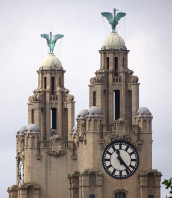
Surely there can be no more iconic sculpture in Liverpool than the Liver Birds on the Royal Liver Friendly Society Building, Pier Head. The Liver Building is itself iconic, with its two companions (Port of Liverpool Building, Cunard Building), and is a great block of a structure with two towers, each made of piled up, ever-decreasing stages with small domes, increasing the sense of overpowering mass and height. The two Liver birds stand at the top of the two towers, giving the distinctive silhouette.
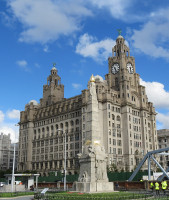 The Royal Liver Building, by W. A. Thomas, Edwardian.
The Royal Liver Building, by W. A. Thomas, Edwardian.
It only takes a moment’s thought to realise that the birds are very large indeed – apparently 18ft high, and with wing-spans of 24 ft. They are made of copper, hollow on an iron armature to avoid being too heavy while maintaining structural integrity.
The statues themselves are not particularly detailed; a pair of rather ungainly birds, heavy, plump bodies supported on stout legs, somewhat short and broad wings raised at an angle rather than being fully outstretched, longish neck and grimacing head, with a sprig of olive clamped in each heavy beak. The feathers are in low relief, without detailing, but we something of the tendons and bones to leg, upper wing and neck. They are not birds of beauty or elegance, but rather quirkiness and defiance. What makes them is their ability to give recognisable shape against the sky from a distance, and to hold their own against the vast mass of the building on which they stand.
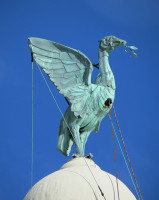
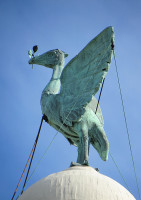 The Liver Birds, by C. B. Bartels.
The Liver Birds, by C. B. Bartels.
Like other Liver birds, they have something of the aspect of a cormorant, yet the neck is less curved, the beak and claws less sharp, the body more solid, and somehow they remind me of the picture of the last Great Flightless Auk in the Water Babies as illustrated by Linley Sambourne, sitting all alone on its outcrop in the harsh sea.
The sculptor is not a familiar figure – Carl Bernard Bartels (1866-1955), a native of Germany who trained as a wood-carver, settled in England, and won a competition to design the Liver birds, according to various web-based information; apparently he later produced some carvings for Durham Cathedral, but I have not noted these. According to BBC News Liverpool, Bartels did not receive the recognition one might expect for the Liver Birds, because of the advent of WW1.
Before turning to the general subject of Liver bird sculpture, we should note that the Royal Liver Friendly Society Building is the design of the architect Walter Aubrey Thomas, and was put up from 1908-10. The consulting engineer was Capt. H. Riall Sankey, and the building was of interest also as being one of the earlier reinforced-concrete structures on the large scale.
What is a Liver bird? Liver birds in general have a long and illustrious history, being loosely derived from the Cormorant, and are found on the Liverpool Coat of Arms from ancient times. It seems that originally there were two cormorants and an eagle – that is to say, a central shield bearing a cormorant, an eagle up above, and a third on a flag held by the figure of Neptune, who is the supporter of the shield on the left hand side (the right hand side has a merman, or triton, also holding a flag, on which is a ship). Over time, there have been many renderings of the coat of arms, and particularly in the 19th Century, when it was used for a range of purposes, from everything from marking buildings with an element of city pride, to advertising on biscuit tins, the birds have varied somewhat, along with other aspects of the heraldry. Seagulls, auks, herons, falcons, even the odd swan. pelican or flamingo have appeared from time to time, and the cormorant – the Liver bird – has varied in proportions from a shorter necked plump bird to a taller one with gracefully arched neck, its feet from webbed to clawed, and its beak from straight and pointed to cruelly hooked. Generally, however, renderings in low relief sculpture show a fairly solid body, with eagle-like talons, rather small wings, a neck with at least some curve, and a long head with a crest or quiff at the back, and the beak with at least some downward curvature if not an outright hook. And in the mouth, a sprig of what was originally seaweed, but has often transmogrified into a small branch of leaves, typically of olive, or something different, such as a fish.
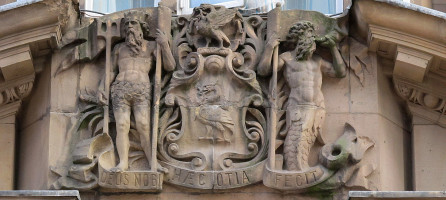 Typical carved Liverpool coat of arms.
Typical carved Liverpool coat of arms.
A wander through Liverpool’s streets identifies a variety of sculpture of the Liverpool coat of arms. Above is a fairly typical example. We have the central field, here a cartouche rather than a shield, bearing a Liver bird carved in low relief with some unidentifiable twig in its beak, crest at the back, curved neck, and a solid body with clawed feet. The second Liver bird, above, fully three dimensional, is rather similar in its features, but has its wings open and upwards – it is common that the lower Liver bird has its wings folded, the upper one open as shown here, and this is essentially the wing-pose of the great Liver birds on the Liver Building discussed above. Beside the shield, the bearers are the figures of Neptune with trident, and triton blowing a horn; both of them hold unfurled flags, but the size and the fact that the flag of Neptune is mostly behind his head and trident means that no attempt has been made to render the third Liver bird. The Latin motto underneath, ‘Deus nobi haec otia fecit’, translating as ‘God has given to us these days of leisure’ is that of the Corporation of Liverpool.
Two further examples of Liverpool’s coat of arms. Above left, the central shield has a standing-up cormorant, with something of the feel of the real perching bird, though the legs are impossibly thin. The smaller Liver bird above has the raised wings and more of a mythological look. The two shield bearers, relatively large, show a vigorous and naturalistic Neptune figure, and a youthful merman with conch; the flags are furled. By contrast, above right, the side figures are lessened in importance compared to the large central cartouche, and as well as the low relief Liver bird in the centre and the small one with raised wings above, if you click to enlarge the picture, you can see the faint low relief of the third Liver bird on Neptune’s flag. The triton figure has a ship on his flag. We may note that the central bird has relatively powerful legs.
Liverpool coat of arms with Liver birds: variations.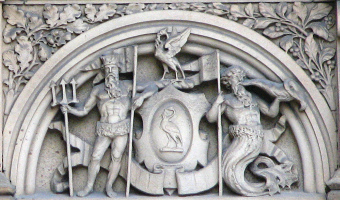
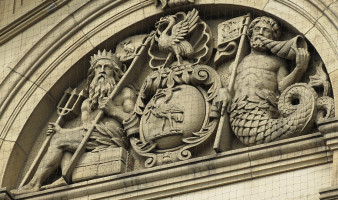
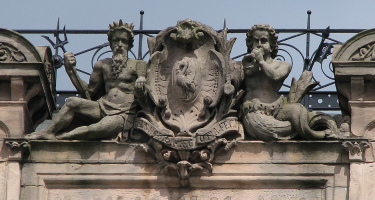
Variations on the theme above. To the left, extremely muscular figures of Neptune and the triton, the latter blowing an extremely large horn, with fairly equally sized upper and lower Liver birds, with the upper one particularly looking somewhat like a phoenix. In the centre, a particularly ornate and heavily undercut version of the Liverpool coat of arms forming an arched pediment to a portico , with equally sized upper and lower Liver birds, and the third Liver bird in high relief on Neptune’s flag. And to the right, the Marks and Spencer Liver bird shield, or cartouche, with seated side figures, still of Neptune and a triton, but no flags or upper Liver bird – the Corporation motto is still included. We may note that the sole Liver bird is shown with wings up, against the convention for the bird in this central position.
Being exposed on the balustrade of a building, the M&S example just noted probably did not include the upper Liver bird as it would have been too delicate for such an exposed position. A different adaptation to the architectural circumstance is shown above, where the coat of arms, still with the Corporation of Liverpool motto, is stretched into a sculptural frieze in high relief. The Neptune and Triton figures have become brothers, with similar physiques, and both with lower parts, so far as we glimpse them between the waves, of fishy, merman type; only the crown and trident of Neptune, and trumpet of the triton, distinguish them. Their small flags are lost behind the scrolls of the central cartouche, on which is the sole Liver bird, with a particularly sinuous neck. At the side, ships, with both oars and sails, stretch the composition. This striking work is on the building at no. 36 Castle Street, noted on this page.
We can keep the general sense of the Liverpool coat of arms while moving away from its attributes. Above left is one of my favourite sculptures in Liverpool, in Bold Street, where Neptune and triton have been exchanged for a merman and mermaid, and in a symmetrical central panel, more of a raised keystone than a shield or cartouche, an identical pair of Liver birds face each other across a tied bundle of logs. Each stands on one leg and has both wings raised, looking more like courting cranes than cormorants, bar the fierce, hook-beaked and crested heads. The centre example has a raised-wing Liver bird on a shield with the flanking figures erplaced by nude Bacchanalian figures, in a rather Louis XV low relief frieze on a building in Church Street. And above right, another version with a symmetrical composition, the pair of dancing Liver birds with tied logs, more phoenix than crane here, and a different motto underneath. As in the Bold Street example, we have merman and mermaid, but the merman has a Neptune trident, and the female figure, in place of the triton of the Corporation coat of arms, blows the horn.
Other Liver bird sculpture: lone birds in cartouches and roundels.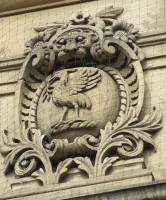
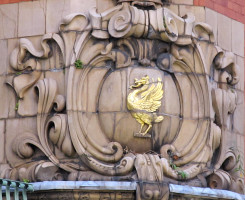
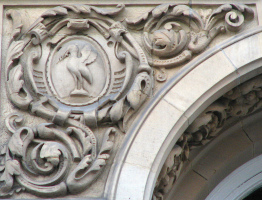
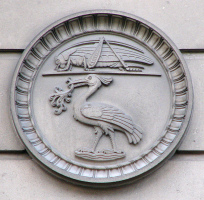
Above are some other Liver birds, still recalling the coat of arms of the city in that they are within central cartouches and face to the left, but with all the other accoutrements gone. To the left, one of the more stocky Liver birds, with flowers and a lion head above, decorative Acanthus leaves below. Then a gilden one, with chicken-like body, duck-like head and feet, holding a fish rather than a branch. Then a spandrel with a small Liver bird of vaguely Dodo type, with small flightless wings held aloft. And a version from Martin’s Bank, with a Liver bird in relief, holding a branch transformed into a curly, decorative frond, is combined with a grasshopper, recalling Thomas Gresham and thus a link to the Royal Exchange and the City of London, appropriate for a bank.
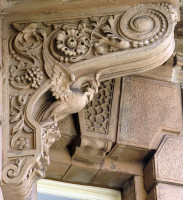
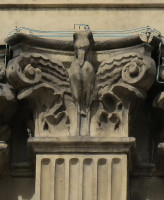 Liver bird sculpture in the round.
Liver bird sculpture in the round.
Finally, I wanted to mention the lone Liver bird as a full statue, which is thus closer to the Liver Building birds where we started this page. The examples above show a bracket bearing a Liver bird, of the Phoenix type, with the sprig of leaves transformed into a ribbon held in the beak, and an Ionic pillar capital transforming into a Liver bird, showing just how versatile the Liverpool emblem can be.
This page was originally part of a 'sculpture of the month' series, for February 2014. Although the older pages in that series have been absorbed within the site, if you would wish to follow the original monthly series, then jump to the next month (Mar 2014) or the previous month (Jan 2014). To continue, go to the bottom of each page where a paragraph like this one allows you to continue to follow the monthly links.
Liverpool's monument to Queen Victoria // Other sculpture in Liverpool // Sculptors // Sculpture in other English towns
Visits to this page from 13 Mar 2014: 40,501